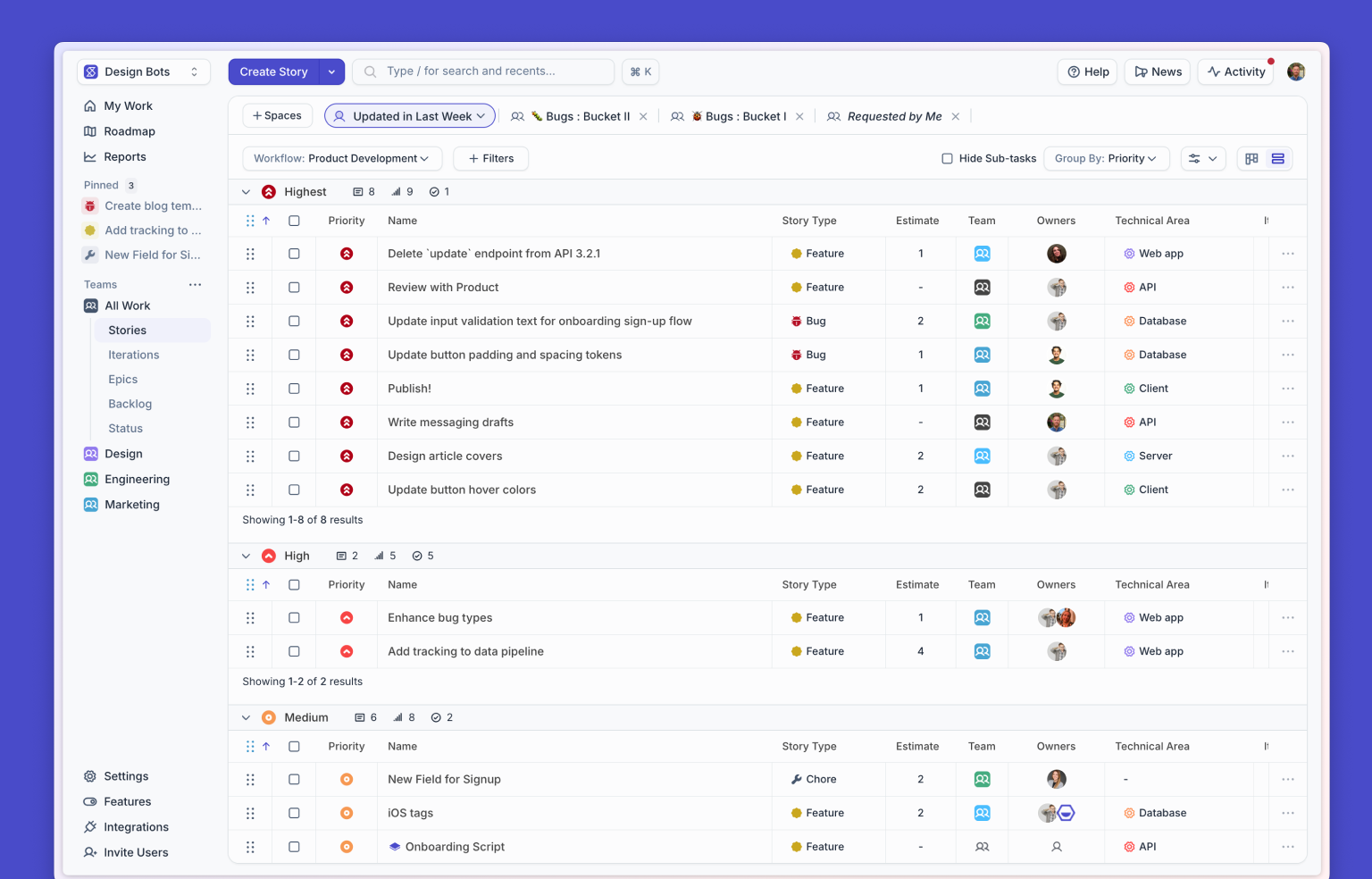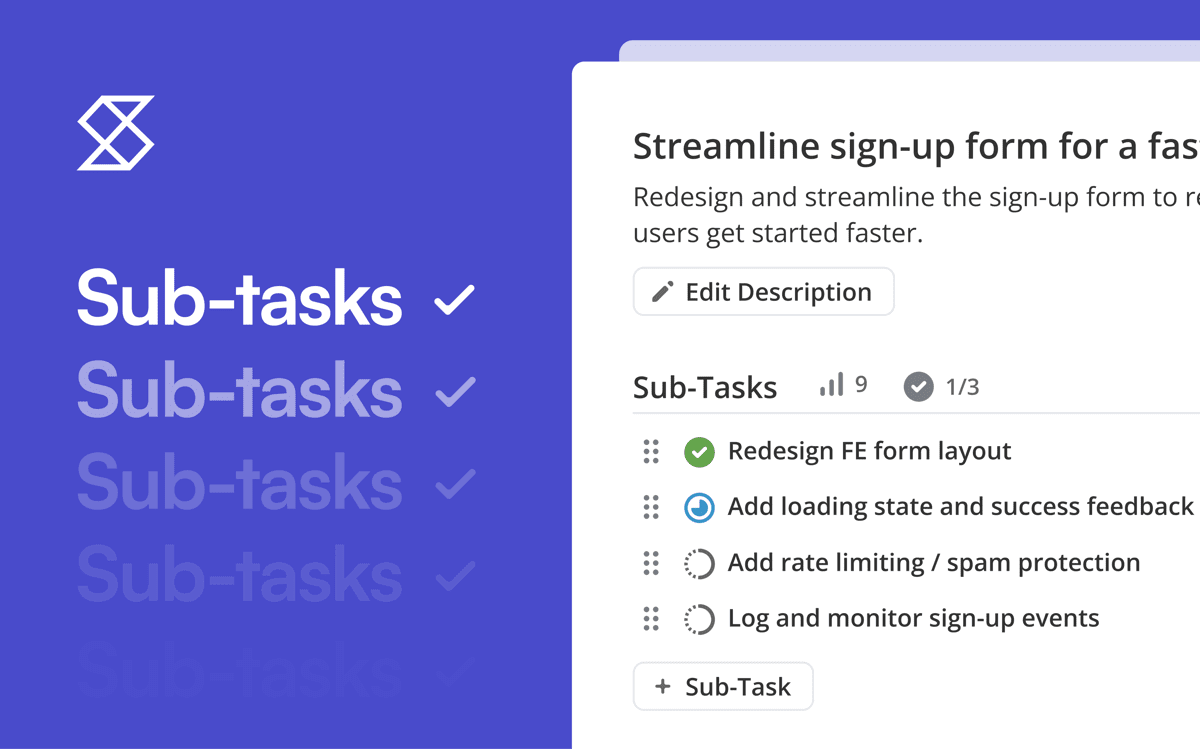Who would win in a software development race between Scrum and Kanban? Or would they forever ship software side by side (until they got tired, of course)?
Kanban is a project management method that helps teams visualize tasks. Scrum is a method that provides structure to the team and schedule.
Some agile teams like to use only Scrum because of its prescriptive nature (there is very little ambiguity), while many scrum teams have adopted select principles of Kanban that are useful in adding an extra layer of visibility to their projects.
Read on to discover which is right for you, and how you can use both in Shortcut. And how everyone wins.
📚Read More: How Shortcut Supports Agile Development
Scrum
Scrum is a lightweight framework that can easily be applied to multiple types of projects.
With Scrum, iterations consist of short sprints, where the goal is to prioritize building the most important features first. This kind of lean thinking reduces waste so that Scrum teams can focus on the essentials.
Transparency, inspection, and adaptation are the three main pillars of scrum methodology.
- Transparency: processes and work must be visible
- Inspection: everyone on the team completes a sprint review to correct undesirable variances
- Adaptation: adjustment period
The Scrum Master
Teams that use scrum are led by a scrum master during each Sprint. At the end of the sprint, there is a sprint retrospective to implement any needed changes.
Essentially, the Scrum Master is responsible for creating an environment where:
- A product owner orders the work for a complex problem into a product backlog.
- The engineering team turns a selection of the work into an increment of value during a Sprint.
- The team and its stakeholders inspect the results and adjust for the next Sprint.
- Rinse & repeat.
How to use Shortcut for Scrum
If your team follows Scrum:
- Sprint planning with Iterations
Sprint planning is a great way to gain clarity on sprint plans (naturally), milestones, launch dates, and backlog. Create an Iteration to prioritize your squad's work and keep everyone apprised of the most important work.
📚Learn more: Iterations Overview
- Use Iterations to prioritize your work during standups
Iterations are a great way to prioritize meetings and standups. To move Stories into an Iteration, filter either by Workflow State or a specific Epic through the Backlog Panel. The key here is that only the unprioritized Stories will appear, which, of course, makes it much easier to see what needs to be prioritized. Then you can drag and drop Stories from the Backlog Panel into your desired Iteration. If you need to re-prioritize work from a past Iteration you can drag and drop Stories into a new Iteration.
- Monitor sprint progress with Iteration Burndown Charts and Cumulative Flow Diagrams
Use the Iteration Burndown Chart to see a visual representation of work completed/remaining over time, and when Stories/Points were added or removed during the course of the Iteration.
Use the Iteration Cumulative Flow Diagram to see work completed over time, grouped by Workflow. This report provides insight into which Workflow States your Stories are in and where bottlenecks might be occurring.
Read More: How to build trust through reporting
Kanban
Kanban project management systems allow you to:
- Visualize, organize, and manage tasks easily
- Track teams’ workflow without needing to do constant follow-ups and meetings
- Track projects in real-time
- Save time by eliminating unnecessary tasks
- Assist with time tracking for agile teams
- Automate certain tasks and workflow
- Come up with reliable forecasts based on past data on workflow
How to Use Shortcut for Kanban
In Shortcut, you can instantly visualize your work with Kanban Boards with full customizable Workflows, real-time progress updates, and flexible shareable views.
- Instantly visualize your work with Kanban boards
There are many ways to view work in Kanban. Head to the Stories page to see all work and filter by Workflow, Epics, Iterations, Projects, users, and more. You can also save a Space if there's a particular Kanban view you access regularly. Check out this Spaces blog post for more information.
- Easily prioritize or shift work as things change from your Kanban view
Drag and drop Stories to prioritize or re-prioritize Stories from one workflow state to another. You can also move Stories up and down in a swimlane to ensure they’re properly prioritized.
Read More: The Kanban Board for Modern Software Teams
Kanban vs Scrum: Key Differences
Though they are both work methods, Kanban is not Scrum and Scrum is not Kanban. There are several key differences.
- Scheduling cadence
Kanban: Products and processes are delivered continuously on an as-needed basis (with due dates determined by the business as needed).
Scrum: Deliverables are determined by sprints, or set periods of time in which a set of work must be completed and ready for review.
- Important metrics
Kanban: Measures production using “cycle time,” or the amount of time it takes to complete one full piece of a project from beginning to end.
Scrum: Measures production using velocity through sprints. Each sprint is laid out back-to-back and/or concurrently so that each additional sprint relies on the success of the one before it.
- Philosophy regarding change
Kanban: Allows for changes to be made to a project mid-stream, allowing for iterations and continuous improvement prior to the completion of a project.
Scrum: Changes during the sprint are strongly discouraged.
- Roles involved
Kanban: There are no pre-defined roles for a team. Although there may still be a Project Manager, the team is encouraged to collaborate and chip in when any one person becomes overwhelmed.
Scrum: Each team member has a predefined role, where the Scrum master dictates timelines, Product owner defines goals and objectives and team members execute the work.
Kanban vs Scrum: Which is Right for You?
The good news is, you don’t really have to choose! Run your own race however you want. Kanban and Scrum can be used side-by-side. So run your race however you want. Feel free to mix and match between both methods, for all cross-functional teams.
We Shortcuteers practice a mix of both, using Iterations to plan and Kanban views to visualize our work. Learn more about how we work by reading The Shortcut Way.
Shortcut is flexible, which means there’s no need to choose between Scrum vs Kanban. Give it a whirl for yourself by signing up for a free trial.

















%20(788%20x%20492%20px)%20(1).png)
.png)

